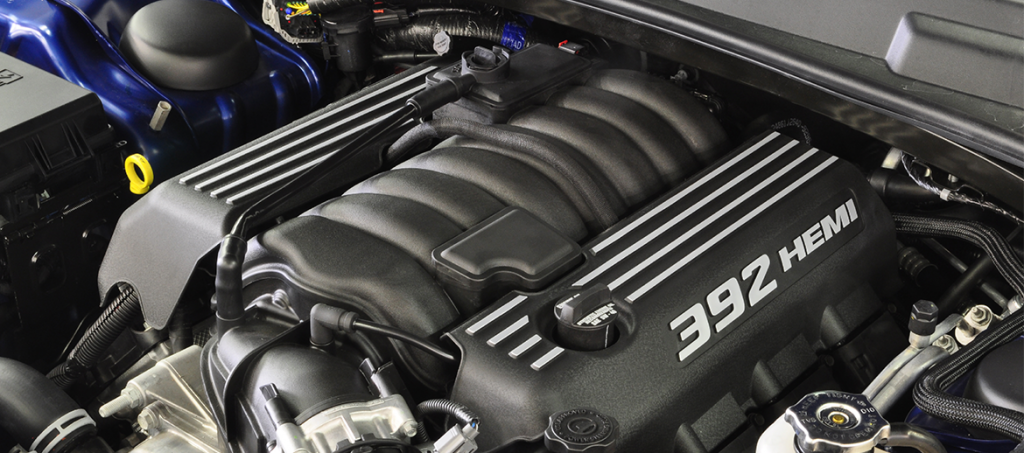The word Hemi conjures up images of big, powerful engines. And for good reason – they are some of the most powerful and sought-after engines on the market. It also powers one of the best classic cars on the market, the 1969 Dodge Charger Daytona. The Plymouth Barracudas also featured the Chrysler’s Hemi.
But what exactly is a Hemi engine, and what makes it so special?
What is a Hemi Engine?

A Hemi is an internal combustion engine with hemispherical combustion chambers. A hemispherical combustion chamber is more efficient than traditional cylindrical combustion chambers because they allow for more complete and efficient fuel/air mixture burning. The engine design also minimized heat loss per unit of volume.
Alfred Ray Welch invented and first built the engine in 1901. In 1905, a Belgian company made the first production car called Pipe. Soon after, other car manufacturers followed suit, with Peugeot, Alfa Romeo and Daimler creating their versions.
Chrysler developed the design as an aircraft engine during World War II and was later adapted for use in race cars and production vehicles. Hemispherical engines featured a combustion chamber in the shape of a hemisphere, with the spark plug located in the center of the chamber. The engine’s Hemi head design promoted more power and less waste.
The first Hemi engine from Chrysler was called the FirePower engine. The Hemi quickly gained popularity among racing teams and performance enthusiasts, thanks to its power and reliability. Over the years, the Hemi engine block has undergone several changes that improved breathing and efficiency.
The 426 Hemi Engine
Introduced in 1965, the 426 Hemi is the most famous Hemi engine. The 426 Hemi soon found its way into drag racing and street cars, originally for use in NASCAR racing.
The 426 Hemi was more powerful than other engines. It was so dominant that NASCAR changed its rules to limit its use. Under the new rules, any engine used in NASCAR racing had to be available for sale to the general public. Since there was no street version of the 426 Hemi available, it was sidelined for the 1965 NASCAR season.
Chrysler introduced a street version of the 426 Hemi in 1966 in response to the ban. It quickly became popular with drag racers and muscle car enthusiasts. Several police cars and other high-performance vehicles also used it.
Newer engines feature flatter heads and are more complex than the first models. Even though they do not have hemispherical chambers, they feature a coil-on-plug distributor-less ignition system. They have two spark plugs for each cylinder to shorten flame travel leading. The engine’s design allowed more consistent combustion while reducing emissions and increasing horsepower.
Popular Chrysler models used these new designs, including the Dodge Durango and Jeep Grand Cherokee. In 2009, Chrysler revised its 5.7-liter Hemi by introducing a Variable Camshaft Timing (VCT) system. VCT controls oil flow into the unique camshaft sprocket using an oil control valve. The valve is opened at high RPMs to improve horsepower. The camshaft sprocket also contains a phasing device that retards or advances the camshaft timing. The company also changed cylinder heads to enhance flow.
Today, specific models already feature an intake manifold. Some Dodge trucks and Ram trucks optimize torque using an active intake manifold featuring a short runner valve. The valve is closed at low RPMs, resulting in better low-end torque.
Why are Hemi Engines So Popular?

There are a few reasons why Hemis are so popular:
- Hemi-powered engines pack a lot of power into a small package, making them ideal for high-performance applications, like muscle cars and race cars.
- It is more efficient than a traditional cylindrical engine since it burns less fuel and produces fewer emissions.
- Hemi engines are known for their durability and reliability, making them a good choice for applications where reliability is essential.
Is the Hemi Better Than the V8 Engine?
People often compare the Hemi with the V8 engines. The combustion chamber shape is the most significant difference between the two. A Hemi’s head has a hemispherical shape, while a V8 has a flat head. The Hemi design helps complete the combustion process more efficiently. The shape allowed it to use large valves that facilitated the flow of exhaust and air, resulting in better combustion.
Chrysler later introduced a multi-displacement system that acts as a cylinder deactivation system. The computer system shuts down cylinders it does not need. The process promotes fuel economy and is unnoticeable to the driver. The system has not experienced any issues since its introduction in 2005.
What’s Special About a Chrysler Hemi Engine?
Hemi engines are more powerful than the designs featuring a wedge-shaped combustion chamber. Wedge-shaped engine designs had an inline arrangement with four slightly smaller valves that let the engine breathe easier.
But the higher compression of the Hemi increases heat, allowing it to use all its potential energy. Chrysler’s enhancements increased its mileage and reliability, particularly with the Hemi V8 engine. Many Chrysler models now sport the Hemi badge, including the Dodge Demon, Dodge Challenger SRT, and some Jeep vehicles. Similarly, some models of the Dodge Ram also feature the badge.
Is Hemi a Powerful Engine?
Even though the modern Hemi went through design changes, it remains powerful. Its power comes from the combustion chamber design. Its internal components can also withstand peak pressure. Factors such as these give it an edge in terms of power and performance.
Chrysler’s design continues to be an icon in the automotive industry. Its popularity has only grown in recent years as classic car enthusiasts and collectors have sought out these powerful engines. The Hemi is truly a work of art and engineering, and its legacy will continue to live on for years to come.

